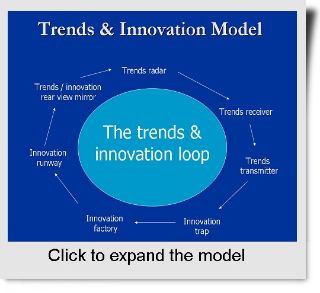 In the world of high-velocity change, how could you go about actually keeping on top of all the trends that might impact your business models, customers, distribution channels, competitors, and markets?
In the world of high-velocity change, how could you go about actually keeping on top of all the trends that might impact your business models, customers, distribution channels, competitors, and markets?
How do you develop a forward-oriented culture that allows you to immerse yourself in the developments occurring in the global innovation feedback loop, and provide for relentless, effective innovation in everything that you do?
With many of my clients, I walk through the “trends and innovation loop” : it’s a model that I developed a number of years ago. It’s a methodology, and a way of thinking, that can help engender an ongoing culture of innovation. There are several elements to the loop, all of which are always operating full-speed, flat-out:
- Trends Radar: Innovation comes from the ability to see the obvious, and so the first step in the loop is to establish a form of “trends radar” that keeps you attuned to the future. Everyone throughout the organization should be prepared to keep a constant eye out for new developments and opportunities that might impact your business or market, and that might provide opportunities for innovation. They should also be watching for trends, issues, or signs that might indicate a potential threat or looming challenge. Everyone needs to understand that having a good radar can help the organization spot future opportunities and act upon them, as well as do what is necessary to ward off and deal with potential threats.
- Trends Receiver: Having your people watch for trends, developments, all issues all around them is the first step in the loop; the second is to instill in them the confidence to share these observations with everyone in the organization. You can call this a collaborative capability: a cultural willingness to share information,
- Trends Transmitter: A good trends receiver is critical to gather all of the observations that your people have, but without a transmitter, the ideas will go nowhere. The trends transmitter is the process of taking the observations and ideas generated from the receiver, sifting through them, and finding the ones that might be important. This is a project and strategic-oriented role, as well as an embedded cultural insight.
- Innovation Trap: Many of the ideas that your trends radar might spot and share won’t make sense, and might be meaningless in the grand context of things. But on occasion, critical information will emerge that might spell a brilliant opportunity or a significant threat. When that happens, you must be able to turn those observations into actionable plans. The trap is a formalized or informal process that takes the best potential observations from the trends transmitter and turns them into concrete ideas and plans.
- Innovation Factory: Your innovation trap can come up with a lot of great ideas, but if you are like many organizations, you’ll fail to see them turn into something that is real and sustainable. Most experts agree that new innovative ideas fail in many organizations, not because of a lack of imagination but due to a basic inability to turn ideas into actionable items. The innovation factory is a cultural willingness to embrace change; it is also the methodology by which new ideas are translated into real business processes, products, activities, and initiatives.
- Innovation Runway: once the ideas have been translated into concrete, actionable plans, you’ll need a method to ensure that they are properly launched and integrated into the organization – that’s your innovation runway. Your actionable plans might involve experts at implementation, project management, and other individuals who can effect change within the organization.
- Innovation Rear-view Mirror: To complete the process, place yourself in a position of continuous re-examination of your innovation success. You must constantly re-evaluate what you’ve learned, what you’ve implemented, and how well it has worked. Use this process to enhance your understanding of how to be innovative, by changing your approach for the next round of the innovation loop.
A LAST WORD
The key to the trends and innovation loop is that it is an ongoing, regular process. It must become part of the very fabric of the organization. A key point to the loop – to make it work, there must be a clear understanding that everyone in the organization is responsible for observing important trends that might impact the organization, for generating innovative ideas, and for helping to put those ideas into practice. Without that type of understanding throughout the organization, most efforts at innovation and dealing with the future will be doomed to fail.




GET IN TOUCH
Jim's Facebook page
You'll find Jim's latest videos on Youtube
Mastodon. What's on Jim's mind? Check his feed!
LinkedIn - reach out to Jim for a professional connection!
Flickr! Get inspired! A massive archive of all of Jim's daily inspirational quotes!
Instagram - the home for Jim's motivational mind!